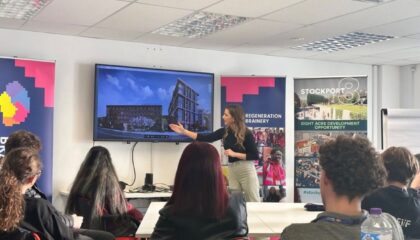Workman Project Management enables investors to make informed decisions based on comprehensive and reliable technical and environmental due diligence in the mid-tech and life sciences sectors, write Partners Richard Fridd and David Baker.
The Spring Budget pledged almost £3.5 billion to support the government’s ambitions to make the UK a scientific and technologic superpower. Funding announced will assist the newly created Department for Science, Innovation and Technology (DSIT) as it strives to develop the UK’s capability in life sciences, green technologies, quantum, AI, engineering biology, semiconductors and future telecoms.
Long called for by the tech and science sectors, the new department is tasked with delivering on the government’s mission to boost the UK’s role as a science and technology innovator.
Although the Workman Project Management team’s experts have been working in both the life sciences and the mid-tech sectors to varying degrees for the past ten years, over the past two to three years they have seen institutional investors become increasingly interested in these two highly competitive industries, as demand for specialist real estate increases in line with market growth.
At the start of 2022, there was in excess of £15bn of live capital in the UK science sector. So far this year, there are already £220m of assets under offer in Oxford and Cambridge.
With our specialists’ knowledge accrued over decades in industrial and commercial sectors, our teams are well-placed to transfer skills to these growth sectors with their distinct needs, advising clients on location strategy, feasibility and development, ESG, securing power supply uplift, and energy efficiency.
Our teams enable clients to make informed investment decisions based on comprehensive and reliable technical and environmental due diligence.
Location strategy
Total investment volumes for life science-related real estate across the “Knowledge Arc” of Oxford and Cambridge hit £1.65bn in 2022, – up c£50 million on 2021 and signifying a record year for the sector.
Oxford and Cambridge both broadly sustained transactional activity in 2022 with other notable deals occurring in locations including Potters Bar and Stevenage, accounting for an additional £200m.
Traditionally, both the life sciences and mid-tech industries have been located in these areas, but demand is out stripping supply.
There’s a current trend for these industries to look towards other cities such as Bristol, which has strong rail and infrastructure networks, and is creating space to take up demand that Oxford and Cambridge cannot meet. This is strengthened by leading research institutions Bristol University and University of the West of England as well as the large teaching and research hospitals based in the city. Bristol is in the top three cities in the UK for inward migration per capita, attracting 21-40 year olds, alongside Oxford and Cambridge, reflecting the city’s growing science ecosystem and talent pool.
A further consideration is just outside Oxford or Cambridge. Workman Project Management specialists have seen locations such as Eynsham increase in popularity where there’s opportunity for those businesses that don’t necessarily need to be at the centre of these science clusters, such as mid-tech type uses.
Feasibility and development advisory
The market is demanding flexible, adaptable space, particularly where development is being carried out speculatively, so that the space constructed can be adapted to meet wide and varied requirements.
The lack of development land in close proximity to Oxford and Cambridge mean that many investors and developers are beginning to look at office and industrial buildings to gauge what can be reasonably converted to life sciences and mid tech.
These properties may not meet levels of specification expected with new build such as large structural floor loading and high floor to ceiling heights. However, as long as a flexible approach is adopted, conversion can be feasible and is providing an alternative and quicker and cheaper option than new build.
At one science park, the Workman Project Management team are looking at conversion of offices to dry or wet laboratory use.
Securing power supply uplift
Life sciences and mid-tech uses are particularly power hungry, so securing the electrical supply needed is often a challenge. This is one of the first elements that Workman Project Management target as a key risk when considering the viability of a new build or conversion schemes in these sectors.
Attaining this scale of change to utility supply can prove extremely challenging, so the Workman Project Management team works to simplify the process, collaborating closely with power infrastructure specialists and clients to ensure that the correct processes are followed, both technically and legally and that the likely power requirements are secured early in the process.
Occupier-driven ESG goals
Since many life sciences and mid-tech companies are sustainable in their own outlook, this approach needs to be reflected in their buildings. These properties are generally being created for long-term occupiers who want a bespoke building that encompasses the best achievable green credentials.
Workman Project Management teams assess the best development or repositioning scenarios to meet the highest ESG standards. For example, we look to ensure that the entire roof structure is capable of supporting solar PV, that the car and bike parking spaces support electric charging, and that there is below-ground water storage to water green roofs. There is also an appetite for green roof initiatives to outbuildings such as cycle sheds and bin stores – operational areas not usually considered at pre-let stages.
Although these features carry extra cost, they are desirable to improve energy efficiency and environmental performance of operationally power-hungry properties. As such, these occupiers are also driving the ESG credentials of buildings.
At one site in Ely, Cambridgeshire, the Workman Project Management team recently delivered a 66,000 sq. ft building earmarked by occupiers as its new headquarters. The property, part offices, part assembly-line, part storage-building is versatile and flexible. The developer had planned for a small section of the roof space to be covered with solar PV to satisfy planning requirements. However, as the occupier recognised their high-power demand, they requested the entire roofscape was covered with solar PV, which provides half their total power supply.
With speculative development for both life sciences and mid-tech, it’s vital to ensure that the roof structure and the roof covering are geared up for total PV coverage, certainly on sun-facing slopes.
Read more about Workman Project Management.
As the life sciences and mid-tech markets continue to grow, particularly given the recent government investment boost, this is a sector likely to demand an increasing share of real estate investment to match.



